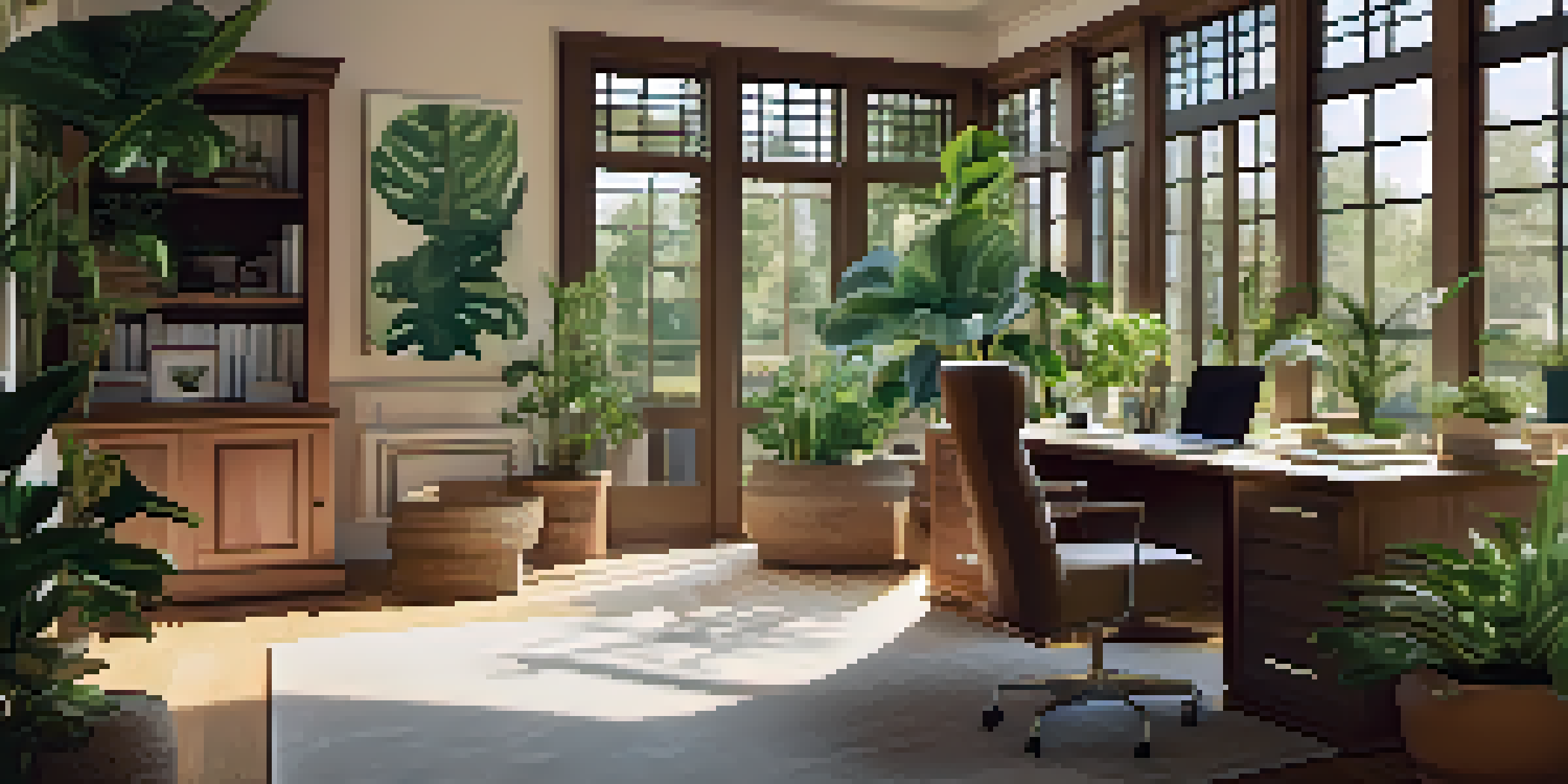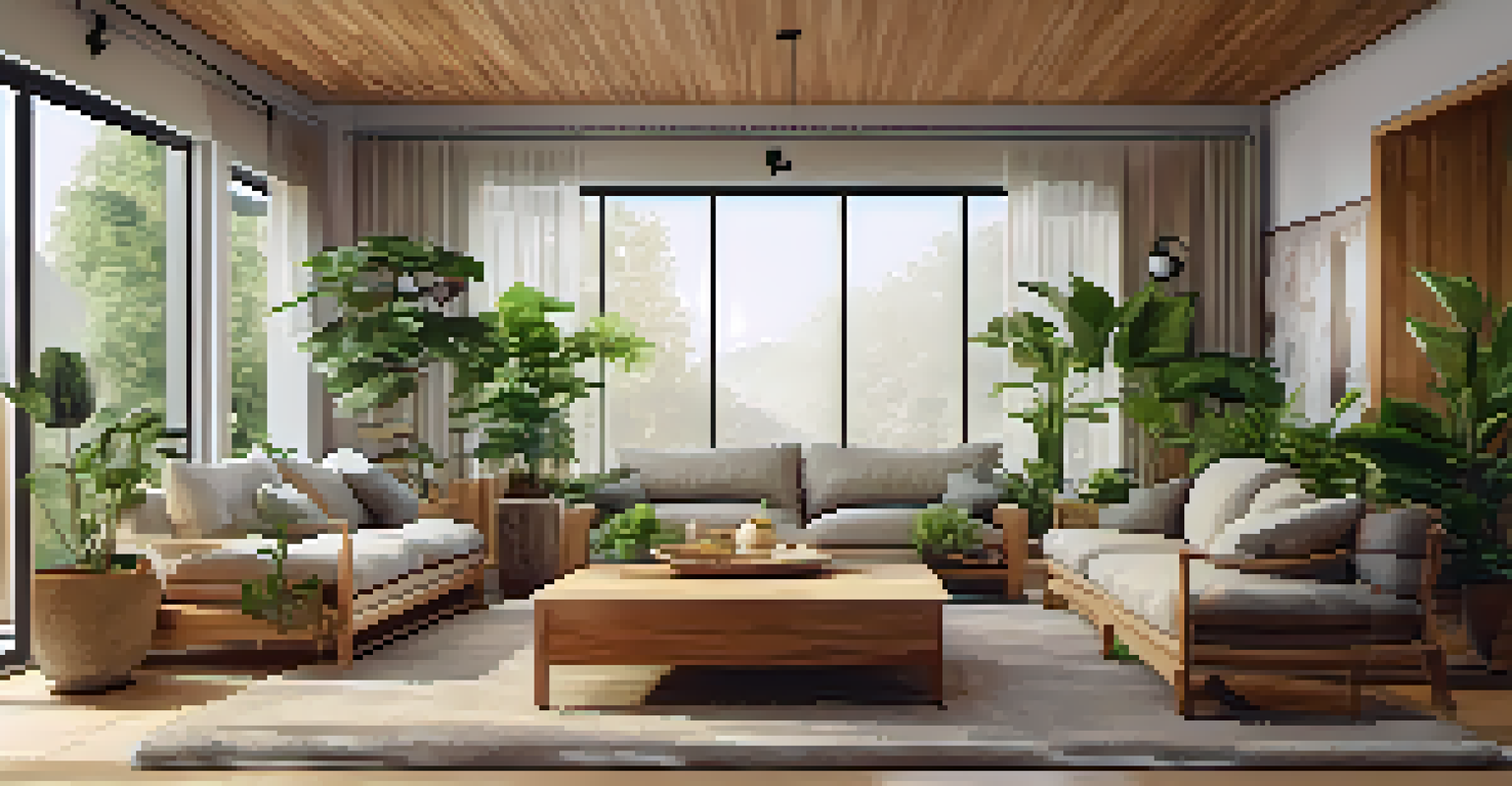The Benefits of Biophilic Design in Healthy Living Spaces

Understanding Biophilic Design and Its Importance
Biophilic design is all about connecting people with nature, even while indoors. It incorporates natural elements like light, plants, and water into our living spaces. This approach not only makes environments more beautiful but also promotes mental and physical well-being.
The greatest threat to our planet is the belief that someone else will save it.
By embracing biophilic design, we can create spaces that support our health and happiness. For example, a room filled with natural light and greenery can reduce stress levels and improve mood. It’s like bringing a piece of the outside world into our homes, fostering a sense of tranquility.
This design philosophy isn’t just a fleeting trend; it’s a fundamental shift in how we think about our environments. As more people seek healthier lifestyles, biophilic design offers a practical solution to enhance our living spaces and overall quality of life.
Enhancing Mental Health through Natural Elements
One of the standout benefits of biophilic design is its positive impact on mental health. Incorporating elements such as plants or natural light can significantly lower anxiety levels. Imagine sitting in a room filled with sunlight and greenery—it's hard not to feel more at ease.

Studies have shown that environments rich in natural features can lead to improved concentration and reduced fatigue. For instance, a workspace designed with biophilic principles often results in higher productivity. It’s as if nature provides that extra boost we all sometimes need during our busy days.
Nature Boosts Mental Well-Being
Incorporating natural elements like plants and light can significantly reduce anxiety and improve overall mood.
Additionally, natural elements can help combat symptoms of depression. By creating spaces that feel more connected to the outside world, we can nurture our mental well-being and foster a more positive outlook on life.
Boosting Productivity with Nature-Inspired Spaces
Biophilic design has been shown to increase productivity in various settings, from offices to homes. When we integrate nature into our workspaces, it creates a refreshing atmosphere that helps us focus better. Think of it as a mental reset, allowing creativity to flow more freely.
Nature does not hurry, yet everything is accomplished.
For example, an office with large windows that overlook greenery can inspire employees and improve their job satisfaction. This connection to nature can be the difference between feeling drained and feeling invigorated throughout the workday.
Moreover, biophilic design often leads to better collaboration among team members. Spaces that encourage interaction while still incorporating natural elements can foster a sense of community and teamwork, further enhancing productivity.
Improving Physical Health with Natural Light
Natural light is a cornerstone of biophilic design, and its benefits to physical health are profound. Exposure to sunlight helps regulate our circadian rhythms, leading to better sleep patterns. Imagine waking up feeling refreshed because your bedroom is bathed in morning light.
Additionally, natural light is linked to increased vitamin D levels, which are essential for bone health and immune function. By designing spaces that maximize sunlight, we promote a healthier lifestyle right from the comfort of our homes.
Productivity Flourishes with Nature
Biophilic design enhances productivity by creating refreshing workspaces that inspire creativity and collaboration.
Furthermore, well-lit spaces can also reduce the need for artificial lighting, leading to lower energy consumption. This means that embracing biophilic design not only benefits our health but also contributes to a more sustainable environment.
Creating Calming Environments with Water Features
Incorporating water features in biophilic design can create a soothing ambiance in any space. The sound of flowing water can have a calming effect, reducing stress and anxiety levels. Just picture a small indoor fountain providing a gentle backdrop as you unwind after a long day.
Water features can also enhance air quality by increasing humidity, which benefits our respiratory health. This is especially important in dry indoor environments where allergies can flare up. By adding a simple water element, we can create a healthier atmosphere.
Moreover, the visual appeal of water can enhance the aesthetic of a room. Whether it’s a wall-mounted waterfall or a small aquarium, these features draw the eye and invite a sense of peace, making our spaces feel more inviting.
Utilizing Natural Materials for Better Air Quality
Biophilic design often emphasizes the use of natural materials, which can dramatically improve indoor air quality. Materials like wood, stone, and organic fabrics can reduce the levels of harmful chemicals found in synthetic alternatives. This shift towards natural substances creates a healthier living environment.
For instance, opting for wooden furniture instead of plastic not only enhances aesthetics but also contributes to better air quality. Natural materials can absorb moisture and help regulate humidity, making spaces feel fresher and more comfortable.
Natural Materials Improve Air Quality
Using natural materials in our spaces can enhance indoor air quality, promoting a healthier living environment.
Additionally, using non-toxic finishes and paints further ensures that our indoor environments remain safe and healthy. By being mindful of the materials we choose, we can create spaces that promote well-being both physically and mentally.
Cultivating a Sense of Community with Shared Green Spaces
Biophilic design extends beyond individual homes, playing a crucial role in fostering community. Shared green spaces, like gardens or parks, encourage social interaction and connection among neighbors. These environments can transform a simple neighborhood into a vibrant community hub.
Imagine a community garden where residents come together to plant, grow, and share the harvest. This not only builds relationships but also promotes a sense of belonging and shared responsibility for the environment. It’s a beautiful way to integrate nature into our daily lives.

Moreover, such spaces can serve as a platform for community events, workshops, and gatherings. By prioritizing green spaces in urban planning, we can create healthier, happier communities that thrive on collaboration and connection.
Incorporating Biophilic Design in Everyday Life
Integrating biophilic design into our daily lives doesn’t have to be overwhelming. Simple steps, like adding houseplants, optimizing natural light, or using natural materials, can make a significant difference. Each small change contributes to a healthier living space.
For example, start with a few potted plants in your home office or arrange your furniture to take advantage of natural light. These adjustments can create a more inviting atmosphere that encourages productivity and relaxation.
Ultimately, embracing biophilic design is about making conscious choices that enhance our well-being. By weaving nature into our environments, we can create spaces that nurture our bodies and minds, paving the way for a healthier lifestyle.